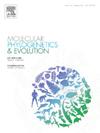Mitochondrial genome and ultraconserved elements reveal a species complex within the Central American brocket deer Mazama temama (Artiodactyla: Cervidae)
IF 3.6
1区 生物学
Q2 BIOCHEMISTRY & MOLECULAR BIOLOGY
引用次数: 0
Abstract
Mazama temama (Kerr, 1792) is a neotropical deer with a wide distribution across the humid forests from Mexico through Colombia. While three subspecies are currently recognized based on morphological and pelage coloration, the presence of a phylogeographic structure is unknown, and recent debates suggest the possibility of it being a species complex. Here, we conduct phylogenetic analyses, explore demographic history, and perform species delimitation analyses using genome-wide ultraconserved elements (UCE) and the whole mitochondrial genome sequenced from museum specimens. Our results reveal three well-supported lineages within M. temama. Based on the mitochondrial dataset, these lineages diverged from the sister clade formed by other Mazama species 2.3 million years ago. The northernmost lineage diverged from southern Central America around 1.2 and 1.4 million years ago, as the UCE and mitochondrial datasets indicated, respectively. The ancestral small population size and Late Pleistocene dispersal patterns contributed to an isolation-by-distance scenario. We propose that M. temama represents a species complex divided by ecological barriers. Consequently, we recommend recognizing three separate species: M. temama (Kerr, 1792) for populations from Mexico to Honduras, M. reperticia Goldman, 1913 for populations from Nicaragua to Panama, and M. zetta Thomas, 1913 for populations in Colombia and Ecuador, limited by the northern Andean Cordillera.

线粒体基因组和超保守元件揭示了中美洲小鹿Mazama temama的物种复合体(偶蹄目:鹿科)
Mazama temama (Kerr, 1792)是一种新热带鹿,广泛分布于从墨西哥到哥伦比亚的潮湿森林中。虽然目前根据形态学和皮毛颜色确定了三个亚种,但系统地理结构的存在是未知的,最近的争论表明它可能是一个物种复合体。在这里,我们进行系统发育分析,探索人口统计学历史,并使用全基因组超保守元件(UCE)和博物馆标本的全线粒体基因组测序进行物种划分分析。我们的研究结果揭示了M. temama中三个得到良好支持的谱系。根据线粒体数据集,这些谱系是从230万年前由其他Mazama物种形成的姐妹进化支中分化出来的。正如UCE和线粒体数据集分别显示的那样,最北端的谱系在120万年前和140万年前从中美洲南部分化出来。祖先的小种群规模和晚更新世的分散模式促成了距离隔离的情景。我们认为,麻豆代表了一个被生态屏障分隔的物种复合体。因此,我们建议识别三个独立的物种:M. temama (Kerr, 1792)用于从墨西哥到洪都拉斯的种群,M. reperticia Goldman, 1913用于从尼加拉瓜到巴拿马的种群,M. zetta Thomas, 1913用于受安第斯山脉北部限制的哥伦比亚和厄瓜多尔种群。
本文章由计算机程序翻译,如有差异,请以英文原文为准。
求助全文
约1分钟内获得全文
求助全文
来源期刊
CiteScore
7.50
自引率
7.30%
发文量
249
审稿时长
7.5 months
期刊介绍:
Molecular Phylogenetics and Evolution is dedicated to bringing Darwin''s dream within grasp - to "have fairly true genealogical trees of each great kingdom of Nature." The journal provides a forum for molecular studies that advance our understanding of phylogeny and evolution, further the development of phylogenetically more accurate taxonomic classifications, and ultimately bring a unified classification for all the ramifying lines of life. Phylogeographic studies will be considered for publication if they offer EXCEPTIONAL theoretical or empirical advances.

 求助内容:
求助内容: 应助结果提醒方式:
应助结果提醒方式:


